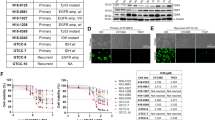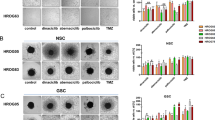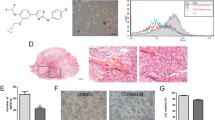Abstract
Medulloblastoma accounts for 20 % of all primary pediatric intracranial tumors. Current treatment cures 50–80 % of patients but is associated with significant long-term morbidity and thus new therapeutic targets are needed. One such target is cyclin-dependent kinase 6 (CDK6), a serine/threonine kinase that plays a vital role in cell cycle progression and differentiation. CDK6 is overexpressed in medulloblastoma patients and is associated with an adverse prognosis. To investigate the role of CDK6 in medulloblastoma, we assayed the effect of CDK6 inhibition on proliferation by depleting expression with RNA interference (RNAi) or by inhibiting kinase function with a small molecule inhibitor, PD0332991. Cell proliferation was assessed by colony focus assay or by the xCELLigence system. We then investigated the impact of CDK6 inhibition on differentiation of murine neural stem cells by immunofluorescence of relevant markers. Finally we evaluated the effects of PD0332991 treatment on medulloblastoma cell cycle and radiosensitivity using colony focus assays. Gene expression analysis revealed that CDK6 mRNA expression is higher than normal cerebellum in fifteen out of sixteen medulloblastoma patient samples. Inhibition of CDK6 by RNAi significantly decreased medulloblastoma cell proliferation and colony forming potential. Interestingly, CDK6 inhibition by RNAi increased differentiation in murine neural stem cells. PD0332991 treatment significantly decreased medulloblastoma cell proliferation and led to a G0/G1 cell cycle arrest. Furthermore, PD0332991 pretreatment sensitized medulloblastoma cells to ionizing radiation. Our findings suggest that targeting CDK6 with small molecule inhibitors may prove beneficial in the treatment of medulloblastoma, especially when combined with radiation.





Similar content being viewed by others
References
Pizer BL, Clifford SC (2009) The potential impact of tumour biology on improved clinical practice for medulloblastoma: progress towards biologically driven clinical trials. Br J Neurosurg 23(4):364–375
Packer RJ, Cogen P, Vezina G et al (1999) Medulloblastoma: clinical and biologic aspects. Neuro Oncol 1:232–250
Packer RJ (2005) Progress and challenges in childhood brain tumors. J Neurooncol 75:239–242
Dhall G (2009) Medulloblastoma. J Child Neurol 24:1418–1430
Taylor MD, Northcott PA, Korshunov A et al (2012) Molecular subgroups of medulloblastoma: the current consensus. Acta Neuropathol 123:465–472
Meyers-Needham M, Lewis JA, Gencer S et al (2012) Off-target function of the sonic hedgehog inhibitor cyclopamine in mediating apoptosis via nitric oxide-dependent neutral sphingomyelinase2/ceramide induction. Mol Cancer Ther 11(5):1092–1102
Lee MJ, Hatton BA, Villavicencio EH et al (2012) Hedgehog pathway inhibitor saridegib (IPI-926) increases lifespan in mouse medulloblastoma model. Proc Natl Acad Sci USA 109(20):7859–7864
Northcott PA, Korshunov A, Pfister S et al (2012) The clinical implications of medulloblastoma subgroups. Nat Rev Neurol 8(6):340–351
Musgrove EA, Caldon CE, Barraclough J et al (2011) Cyclin D as a therapeutic target in cancer. Nat Rev Cancer 11(8):558–572
Ericson KK, Krull D, Slomiany P et al (2003) Expression of cyclin-dependent kinase 6, but not cyclin-dependent kinase 4, alters morphology of cultured astrocytes. Mol Cancer Res 1(9):654–664
Grossel MJ, Hinds PW (2006) Beyond the cell cycle: a new role for CDK6 in differentiation. J Cell Biochem 97(3):485–493
Malumbres M, Barbacid M (2009) Cell cycle, CDKs and cancer: a changing paradigm. Nat Rev Cancer 9(3):153–166
Mendryk F, Radlwimmer B, Joos S et al (2005) Genomic and protein expression profiling identifies CDK6 as novel independent prognostic marker in medulloblastoma. J Clin Oncol 23(34):8853–8862
Wu J, Qian J, Li C et al (2010) miR-129 regulates cell proliferation by downregulating CDK6 expression. Cell Cycle 9(9):1809–1818
Pierson J, Hostager B, Fan R et al (2008) Regulation of cyclin dependent kinase 6 by microRNA 124 in medulloblastoma. J Neurooncol 90:1–7
Leonard JP, LaCasce AS, Smith MR et al (2012) Selective CDK4/6 inhibition with tumor responses by PD0332991 in patients with mantle cell lymphoma. Blood 119(20):4597–4607
Schwartz GK, LoRusso PM, Dickson MA et al (2011) Phase I study of PD0332991, a cyclin-dependent kinase inhibitor, administered in 3-week cycles (Schedule 2/1). Br J Cancer 104:1862–1868
Venkataraman S, Alimova I, Fan R et al (2010) MicroRNA 128a increases intracellular ROS level by targeting Bmi-1 and inhibits medulloblastoma cancer cell growth by promoting senescence. PLoS One 5(6):e10748
Barton VN, Donson AM, Kleinschmidt-DeMasters BK et al (2010) Unique molecular characteristics of pediatric myxopapillary ependymoma. Brain Pathol 20(3):560–570
Xing JZ, Zhu L, Jackson JA et al (2005) Dynamic monitoring of cytotoxicity on microelectronic sensors. Chem Res Toxicol 18:154–161
Su X, Gopalakrishnan V, Stearns D et al (2006) Abnormal expression of REST/NRSF and Myc in neural stem/progenitor cells causes cerebellar tumors by blocking neuronal differentiation. Mol Cell Biol 26(5):1666–1678
Northcott PA, Korshunov A, Witt H et al (2011) Medulloblastoma comprises four distinct molecular variants. J Clin Oncol 29(11):1408–1414
Lapenna S, Giordano A (2009) Cell cycle kinases as therapeutic targets for cancer. Nat Rev Drug Discov 8(7):547–566
Toogood P, Harvey PJ, Repine JT et al (2005) Discovery of a potent and selective inhibitor of cyclin-dependent kinase 4/6. J Med Chem 48(7):2388–2406
Beukelaers P, Vandenbosch R, Caron N et al (2011) CDK6-dependent regulation of G1 length controls adult neurogenesis. Stem Cells 29:713–724
Michaud K, Solomon DA, Oermann E et al (2010) Pharmacologic inhibition of CDK4/6 arrests the growth of glioblastoma multiforme intracranial xenografts. Cancer Res 70(8):3228–3238
Menu E, Garcia J, Huang X et al (2008) A novel therapeutic combination using PD 0332991 and Bortezomib: study in the 5T33MM myeloma model. Cancer Res 68(14):5519–5523
Acknowledgments
This work was supported by NINDS K08 NS059790 (RV) and the Morgan Adams Foundation (RV, NKF). Imaging experiments were performed in the University of Colorado Anschutz Medical Campus Advance Light Microscopy Core supported in part by NIH/NCRR Colorado CTSI Grant Number UL1 RR025780.
Conflict of interest
The authors declare that they have no conflict of interest.
Author information
Authors and Affiliations
Corresponding author
Electronic supplementary material
Below is the link to the electronic supplementary material.
Supplementary Fig. 1
Quantifying bar graphs show significant decrease in CDK6 mRNA expression in Daoy and ONS-76 medulloblastoma cell lines after transfection with shRNA targeting CDK6. Error bars represent SEM. (***P<0.001) (TIFF 19241 kb)
Supplementary Fig. 2
Subgroup analysis of microarray data in 120 medulloblastoma patients show CDK6 mRNA expression is statistically higher in the Wnt subgroup than Group 3 and Group 4. (**P<0.01, ***P<0.001) (TIFF 15944 kb)
Supplementary Fig. 3
Nonlinear regression lines for Daoy and ONS-76 cells treated with PD0332991 followed by radiation. The R2 values for each line are listed below their respective graphs (TIFF 19707 kb)
Rights and permissions
About this article
Cite this article
Whiteway, S.L., Harris, P.S., Venkataraman, S. et al. Inhibition of cyclin-dependent kinase 6 suppresses cell proliferation and enhances radiation sensitivity in medulloblastoma cells. J Neurooncol 111, 113–121 (2013). https://doi.org/10.1007/s11060-012-1000-7
Received:
Accepted:
Published:
Issue Date:
DOI: https://doi.org/10.1007/s11060-012-1000-7




